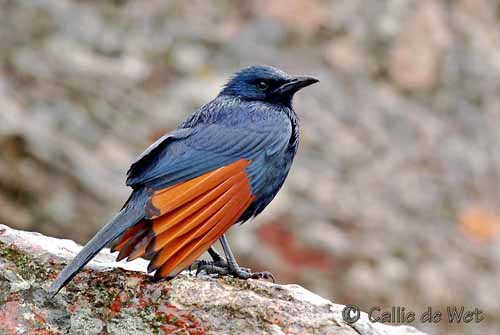
Fr: Rufipenne morio
All : Rotschwingenstar
Esp: Estornino Alirrojo
Ital: Storno alirosse africano
Nd: Roodvleugelspreeuw
Sd: Rödvingad glansstare
Photographers:
Didier Buysse
Vision d’Oiseaux
Callie de Wet
GALLERY
Text by Nicole Bouglouan
Sources:
HANDBOOK OF THE BIRDS OF THE WORLD Vol 14 by Josep del Hoyo-Andrew Elliot-David Christie - Lynx Edicions – ISBN: 9788496553507
BIRDS OF AFRICA SOUTH OF THE SAHARA by Ian Sinclair and Peter Ryan - Princeton University Press Princeton and Oxford - ISBN: 0691118159
ROBERTS BIRDS OF SOUTH AFRICA by G. R. Mc Lachlan and R. Liversidge – The Trustees of the John Voelcker Bird Book Fuund – ISBN: 0620031182
BirdLife International (BirdLife International)
Wikipedia, the free encyclopaedia
Red-winged Starling
Onychognathus morio
Passeriforme Order – Sturnidae Family
BIOMETRICS:
Length : 30 cm
Weight : 115-155 g
DESCRIPTION:
The Red-winged Starling is an African species, fond of bright-coloured fruits. It may be very aggressive in nest-defence, even attacking humans.
Adult male has glossy black plumage with dark blue sheen overall, except on the wings where the primary flight feathers are bright chestnut with narrow blackish tips. On folded wings, only a rufous patch is visible. The rather long, pointed tail is black.
The strong bill is black. The eyes are dark red. Legs and feet are black.

The female is very similar in plumage, but she has brownish-grey head, chin, throat and upper breast.
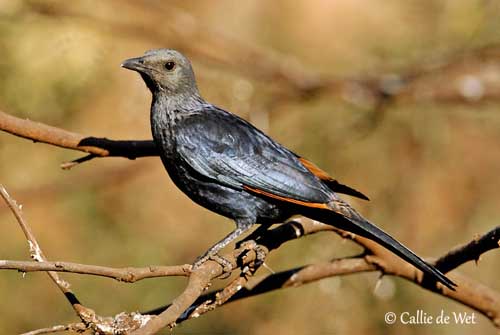
The juvenile resembles male but duller and less glossy. It has brown bill and eyes.
In addition of the nominate race O.m. morio, we can find O.m. rueppellii which is larger with larger tail.
VOICE: SOUNDS BY XENO-CANTO
The Red-winged Starling’s common call is a plaintive, drawn-out “spreeu”. The contact call is a two notes “twee-twoo”. The alarm call is a harsh “tchorr”. During the nest defence when it attacks intruders, it gives a low “kwok-kwok”.
The song is musical but complex, including melodious whistles and warbling notes. Male and female sing and the flocks produce mixed sounds with whistles and song phrases.
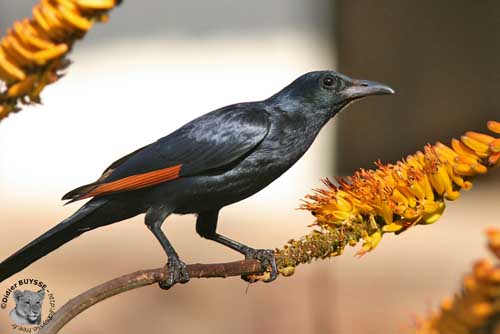
HABITAT:
The Red-winged Starling is very common in numerous urban areas, but its original habitat is quite different. This bird frequents the mountainous areas with rocky outcrops and gorges, with access to vegetated feeding grounds.
This species occurs up to 2500 metres in Ethiopia, and can be seen up to 4000 metres or more in Uganda. In South Africa, this starling is present from sea-level up to 3000 metres of elevation.
However, it usually avoids the arid regions and the lowlands of the East Coast.
RANGE:
The Red-winged Starling occurs from the Cape Province to Ethiopia.
It is mainly resident in its range. During the non-breeding season, nomadic flocks of about 200 birds are reported.
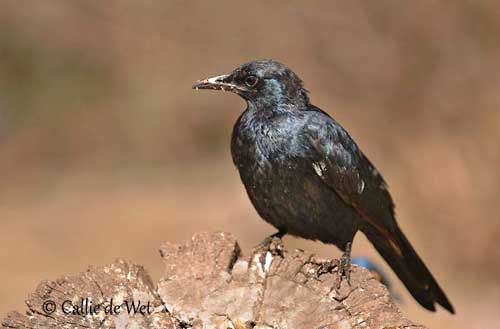
BEHAVIOUR:
The Red-winged Starling is mainly frugivorous and highly opportunistic. It feeds on numerous fruits and berries from several plant species; it also takes seeds and nectar. The smallest seeds are retained in the gut and carried farther, whereas the largest ones are regurgitated.
It also consumes animal food such as amphibians, lizards, freshwater crabs, carrion, scorpions, spiders, large insects and numerous others, snails and molluscs.
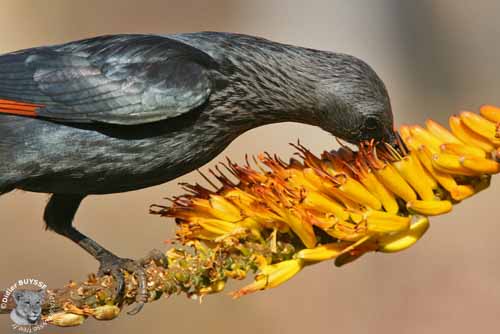
The Red-winged Starling forages by hopping on the ground, but also in trees and bushes. It may feed in intertidal area. The larger preys are broken up on anvils such as stones near the nest, and the chicks are fed with small pieces.
It frequents large mammals from which it removes ticks and gleans ectoparasites. Very opportunistic, it scavenges food at picnic sites and restaurants.
They often occur in pairs or small flocks. They gather at communal roost at night on cliffs, tall trees or buildings, where up to 500 birds or more may roost together. They sometimes roost in reedbeds with other bird species.
During the breeding season, the Red-winged Starling becomes aggressive around the nest-site, and it attacks all intruders, humans or animals and birds.
This species is monogamous and the pair-bonds may last for several breeding seasons. It does not use cavity for nesting unlike numerous Sturnidae species.
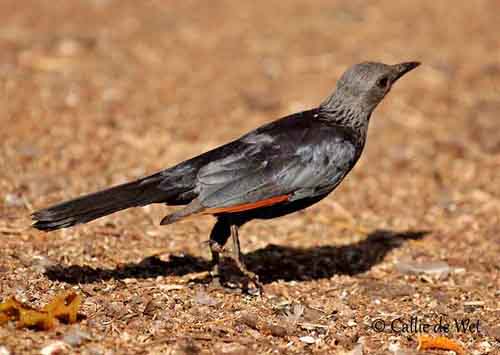
FLIGHT:
The chestnut flight feathers are conspicuous in flight. Wings and tail proportions may vary throughout the range, but there is no ecological explanation for these variations probably due to the habitat type.
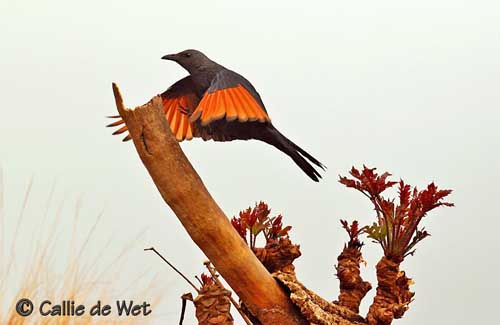
REPRODUCTION:
The breeding season varies according to the range. This species often produces two broods per season.
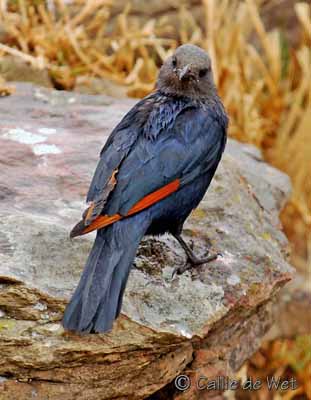
Unlike numerous starlings, The Red-winged Starling builds its nest on ledge on rock or cliff, but now also on buildings, and sometimes on leaf bases of palms. The nest-site is often reused for several successive years.
The nest is made with mud, grass, rootlets and sticks, and lined with finer grass, horsehair and also non-natural materials.
The female lays 2-4 eggs and incubates during about two weeks. The male feeds her at nest during this period. The chicks are fed by both parents, and they fledge about 22-28 days after hatching.
The nest can be parasitized by the Great Spotted Cuckoo (Clamator glandarius) in some regions. The usual nest predators are the Pied Crow (Corvus albus), the African Harrier-Hawk (Polyboroides typus), and baboons.
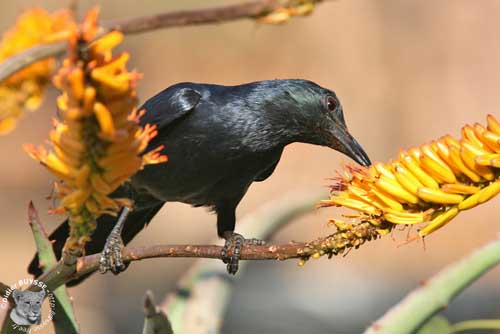
DIET:
The Red-winged Starling feeds mainly on fruits and seeds from numerous plant species. It also takes insects, molluscs, snails, spiders, amphibians, lizards, scorpions, carrion…
It forages on the ground, in trees and in bushes. This is a very opportunistic species.
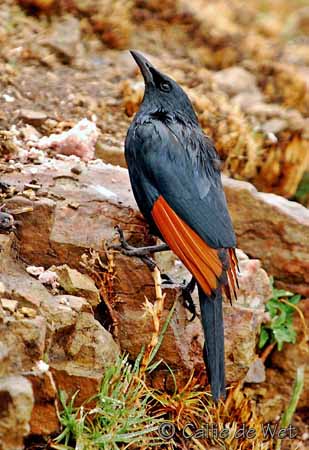
PROTECTION/THREATS/ STATUS:
The Red-winged Starling is widespread and abundant in most parts of the range. This species is considered a pest in some regions where it damages the fruit crops. Its populations are not currently threatened.